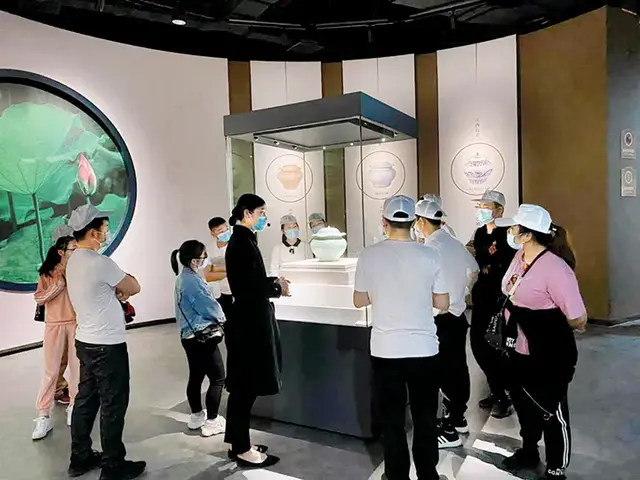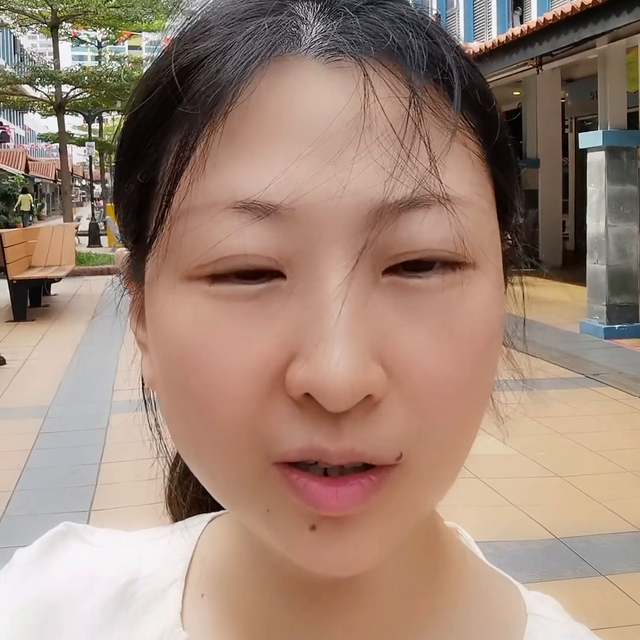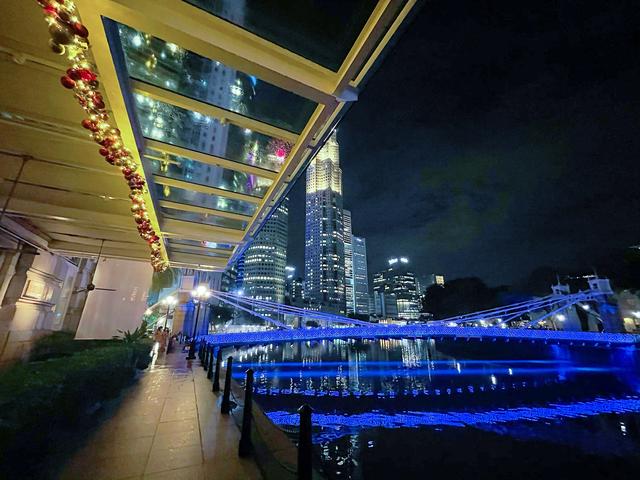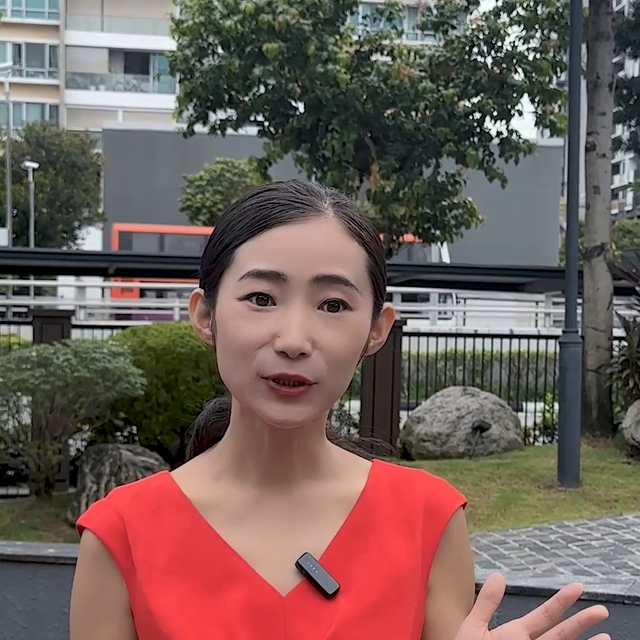宋瓷之美——极简主义的宋代美学(中英文)


The beauty of Song Dynasty ceramics
文/图 《一带一路报道》记者 向雯
第一次踏入位于遂宁的四川宋瓷博物馆,仿佛一头撞进了宋朝的时空。原本厚重的历史文物置于宋代文人雅士的生活美学中,通过茶器、酒器、花器、香器、文房等物件,将插花、焚香、点茶、挂画的宋人生活四艺一一展现眼前。
Stepping into Sichuan Song Dynasty Ceramics Museum in Suining, Sichuan, for the first time, I felt as if I had entered the time and space of the Song Dynasty. The relics with profound cultural meaning reflect the life aesthetics of literati living in the Song Dynasty. Through tea ware, drinking vessel, vase, incense burner, and calligraphy tool, the four life arts of ancient Chinese in the Song Dynasty, including flower arrangement, incense burning, tea whisking and painting appreciation, are presented.

遂宁市文化中心(网络图片)
极简主义的宋代美学
Simplicity of Song Dynasty aesthetics
闲适淡雅、素静飘逸是宋代主流审美的概括。“与盛唐相比,(宋)时代精神已不在马上,而在闺房;不在世间,而在心境……心灵的安逸享受占据首位。不是对人世的征服进取,而是从人世的逃遁退避;不是人物或人格,更不是人的活动、事业,而是人的心情意绪成了艺术和美学的主题。”李泽厚在《美的历程》中如是说。
Simplicity is the mainstream aesthetic orientation in the Song Dynasty. “Unlike those in the glorious age of Tang Dynasty, people in the Song Dynasty had no longer focused on wars but love, not physical quest but spiritual one... People placed spiritual satisfaction at the first place. People wanted to forsake the world, but not conquer it. It was not someone or someone’s personality, nor was it someone’s activity or career, but the mood of the person that became the theme of art and aesthetics,” written in Li Zehou’s book—The Path of Beauty.
宋朝被认为是中国传统文化与审美的“黄金时代”,从诗词绘画、居家器用到建筑园林等,宋人一改汉唐以来的金银奢靡之风,反而追求极简之美,形成了品调高雅的造物艺术。有西方学者将宋朝誉为“中国绘画和陶瓷的伟大时期”。现代考古发现的古代陶瓷遗址中,宋代窑址占据了“大半江山”,不论是在种类、样式还是烧造工艺等方面,宋瓷都居于极其重要的地位。
The Song Dynasty is regarded as the “golden age” of Chinese traditional culture and aesthetics. From poetry and painting, household wares and tools to garden architecture, people in the Song Dynasty abandoned the luxury style featuring shiny gold and silver elements prevalent since the Han and Tang dynasties. Instead, they pursued the beauty of simplicity and created elegant arts. Some western scholars hailed the Song Dynasty as “the great period of Chinese painting and ceramics”. Among the ancient ceramic sites discovered by modern archaeologists, the Song Dynasty kiln sites account for more than half of them. No matter in the category, style or kiln technology, Song Dynasty ceramics all occupy a very important position.
比利时收藏家马克曾用西方艺术理论分析宋瓷:“它的器形美在线条上,吸收了中国绘画的精髓,有对称的美感;表现手法简洁,只用釉色说话,而少有纹饰,跟西方极简主义的手法有相似点。”
Mark, a Belgian collector, once analyzed Song Dynasty ceramics by using western art theories, saying that its shape beauty is reflected in its lines, which absorb the essence of Chinese painting and present the beauty of symmetry. The design is simple as few decorations are used but only glaze used to color the object, which is similar to western minimalism.

青釉荷叶形带盖瓷罐
宋瓷博物馆展出的藏品是南宋瓷器的珍品。在展厅最显眼的位置,“青釉荷叶形盖罐”独居其间,与背景中的荷花莲叶图交相呼应,圆润的罐身搭配呈荷叶状弯曲的盖沿,一静一动间,仿佛这片荷叶下一刻就会随风轻漾……
The collection exhibited in the museum are ceramic masterpieces in the Southern Song Dynasty. The celadon glaze jar with lotus leaf shaped lid is placed at the most prominent position in the exhibition hall. Against the backdrop of a painting with lotus flowers and leaves, it seems as if the lotus leaf shaped lid on the rounded jar would wave in the breeze...
如何欣赏这个被誉为“瓷器三大国宝之一”的青釉荷叶形盖罐?为此,记者请教了遂宁市文物管理局局长、四川宋瓷博物馆馆长何瀛中:“一看形,这是迄今为止南宋龙泉青瓷中最大的一件;二观色,古人尚玉,荷叶盖罐通过多次施釉呈现出胎薄釉厚的特点,青翠莹润的梅子青色可媲美翡翠;三品意,荷叶盖罐通身光洁无纹饰,简约的造型也反映了当时的社会审美,崇尚自然淡雅。”
How to appreciate this collection, which is hailed as “one of the three national ceramic treasures” . He Yingzhong, Director of Suining Cultural Relics Bureau and Curator of Sichuan Song Dynasty Ceramics Museum, said: “First, to appreciate the shape. This is the largest piece of celadon produced in Longquan kiln in the Southern Song Dynasty till now. Second, to appreciate the color. Ancient Chinese people revered jade. This piece of celadon has an eggshell-like body with thick color after several glazing procedures. The jade-like plum green color thus enables it to rival the jade in beauty. Third, to appreciate aesthetics. The jar body is smooth without decorative motifs. This simple design also reflects the aesthetics at that time when simplicity prevailed.”
青釉是宋代龙泉窑(今浙江省龙泉市)的代表作品,而梅子青釉更是当时青釉瓷器的巅峰之作。据了解,梅子青品种的瓷器仅在南宋一朝烧造,存世极少,这件青釉荷叶形盖罐正是其中最具代表性的珍品。
Ceramics with celadon glaze were the representative works of Longquan Kiln (located in Longquan county, Zhejiang)in the Song Dynasty, and those with plum green color were crowning achievements at that time. The celadons with plum green color were fired in the Southern Song Dynasty only, and few are preserved till today. And the celadon glaze jar with lotus leaf shaped lid is one of the most representative treasures.
“碧绿如翡翠,温润如春水”是对龙泉窑青瓷最佳的注解,和青釉荷叶形盖罐一同出土的其余984件瓷器,也有着相似的审美意趣。无论这批窖藏中占比最大的龙泉青瓷、景德镇青白瓷,抑或是少量的河北定窑、陕西耀州窑,甚至是西南地区的磁峰窑、清溪窑,都让后来者一窥750多年前中国陶瓷史上最辉煌年代的精神风貌。
“As green as emerald, as gentle as spring water” is the best description of celadons in Longquan Kiln. The remaining 984 pieces of ceramics unearthed also reflect similar aesthetics. Whether they are Longquan celadons and Jingdezhen bluish white porcelains, which account for the largest proportion of the collections in the museum, or the handful of ceramics from Ding kiln in Hebei Province, Yaozhou kiln in Shaanxi Province, or even the Cifeng kiln and Qingxi kiln in southwest China, all offer a glimpse into the golden age in the history of Chinese ceramics more than 750 years ago.

青白釉三足蟾蜍形瓷水丞
“聚宝盆”之探究
Exploring the treasure site
这批于1991年9月在遂宁市南强镇金鱼村出土的瓷器窖藏,除了大量瓷器以外,还包含18件铜器、2件石器,总数多达1005件。破土重生之时,因其数量大,品质高在国内引发过巨大的轰动。
The relics unearthed in September 1991 in Jinyu Village, Nanqiang Town, Suining City, contained 18 pieces of bronze ware and 2 pieces of stone ware in addition to a number of ceramics, totaling 1,005 pieces. The discovery caused a great sensation in China with the large quantity and high quality of relics.
位于四川盆地中部腹心的遂宁并不以盛产瓷器闻名,为何这批国宝级的瓷器会掩埋于此?窖藏主人又是谁?这一连串的疑问引发了学术界的猜测,专家学者也做了许多溯源研究。“目前,学界对这批窖藏的主人有四种推测,一是皇亲贵胄,二是当地官府,三是富商巨贾,四是学府书院。”何瀛中告诉记者,“因没有确切的文字证据,这四种推测都有其存在的合理性。”
Suining, located in the heart of the central Sichuan basin, is not famous for its ceramic production. So, why were national treasure ceramic and pottery unearthed here? And who owned the hoard? A series of questions triggered the speculation in the academia, and experts and scholars have also done a lot of research to trace to the source. “At present, there are four theories about the owner of the hoard, that is, nobles, local officials, rich businessmen, and academies, respectively,” He Yingzhong said, adding “all four theories are reasonable due to the lack of conclusive written records.”

青白釉缠枝花卉纹瓷梅瓶
宋代时,四川盆地宛如一个“聚宝盆”,商品经济延续了唐代以来的繁华,以丝织品、茶叶为代表的产品是四川与外界贸易的主要商品,而各地的特色产品包括海外贸易带来的香料等也大量通过商品交易进入了四川。在两宋时期,以成都平原为中心的地区就是除京师和东南沿海以外的香料等奢侈海外贸易品的最大消费地。
Sichuan Basin was like a cornucopia in the Song Dynasty. At that time, commodity economy has continued the prosperity since the Tang Dynasty. The representative goods--silk and tea are the main commodities traded between Sichuan and other regions. And products with local features from outside world includes spices that were introduced through overseas trade also flooded into Sichuan through trading. For example, during the Two Song Dynasties, areas centered on Chengdu Plain were the largest consumption market for luxury imported goods, such as spices, besides the capital and the southeast coastal area.
而金鱼村窖藏所在的遂宁市,从唐末、五代开始便是遂州的州治所在。宋代遂宁的农业、丝织业和盐业的生产都有了非常迅速的发展。其中,遂州织造的樗蒲绫在当时已经成为与成都蜀锦齐名的丝织品。此外,遂宁所在的涪江流域在南宋时期交通也十分便利,四川的丝织品远销川外,返川时运回的则是当地的特色商品,其中就包括了位于长江中下游景德镇窑和龙泉窑的瓷器。
And Suining City, where many ceramics were unearthed in its Jinyu Village, has been the administrative center of Sui State since the late Tang Dynasty and the Five Dynasties. During the Two Song Dynasties, Suining’s agriculture, silk and salt industries developed rapidly. In particular, Chupu silk produced in Sui State at that time enjoyed equal popularity as the Shu Tapestry. In addition, the Fujiang River basin where Suining is located enjoyed convenient transportation in the Southern Song Dynasty. Sichuan’s silk goods were shipped and sold to other regions and local commodities in these areas, including Jingdezhen porcelains and Longquan ceramics produced in the middle and lower reaches of the Yangtze River, were then transported to Sichuan.
然而,随着蒙古帝国在北方草原的崛起,宝庆三年(1227年),长达52年的宋元战争拉开序幕,经贸繁荣的四川地区成了双方争夺的主要战场。资料显示,在宋代的四川范围内,已经发现的宋代窖藏多达数十处,其中不少窖藏的年代都在南宋晚期,而金鱼村窖藏出土的瓷器是其中数量最大、质量最优的一批,这在四川乃至全国范围内都非常罕见。
However, with the rise of the Mongolia Empire in the northern prairie, the 52-year Song-Mongol war began in 1227. Sichuan, with its booming economy and trade, became the main region the two sides battled for. Data show that there are dozens of Song Dynasty relic sites found in areas within ancient Sichuan, many of which date from the Late Southern Song Dynasty. And the ceramics unearthed from Jinyu Village have the largest quantity and the best quality, which is rare in Sichuan and even in China.

青釉贯耳大瓷瓶
其中一件镌刻着“凤翔楼钱鑫”铭文的青铜器引发了专家的兴趣。“钱鑫”有钱庄之意,“凤翔楼”应该是店号。专家推测,这批瓷器的目的地或许不是遂宁,也可能是商贾将瓷器从龙泉运到遂宁中转,连同四川本地的丝绸、茶叶、药材等,通过南方丝绸之路,输送到南亚等地。但由于南宋末年宋元之战的缘故,这批青瓷被就地掩埋。
Of these, a piece of bronze ware inscribed with words “Fengxianglou Qianxin” has sparked the interest of experts. “Qianxin” means “old-style bank”, and “Fengxianglou” may be the bank name. According to the estimation of experts, the celadons unearthed here might not be destined for Suining. Experts estimated that merchants intended to transport the goods from Longquan to Suining together with Sichuan’s silk, tea and medicinal materials and then to South Asia through Southern Silk Road. However, due to the war between Song-Mongol war in the late Southern Song Dynasty, they had to bury their celadons here.
回忆起当初发掘时的情形,何瀛中谈道,从这批精美的瓷器被匆匆掩埋可以看出当时战争的残酷。“在清理文物中,我们还有意外发现。青釉荷叶形盖罐内居然整齐叠放着99件形制相同的青白瓷菊花口小碟,而根据罐内的空间还可以放更多。” 何瀛中解释,“九”在中国传统文化中有长久之意,专家猜测所谓“九九归一”,可能也寄托着窖藏主人对家国安宁,平安顺遂的美好寓意。
Recalling the moment when the relics were unearthed, He Yingzhong said the hasty burial of the delicate pieces can show us the cruelty of the war at that time. “When sorting out these relics, we found something by chance. Inside the celadon glaze jar with lotus leaf shaped lid, there are 99 pieces of same chrysanthemum-mouth bluish white porcelain saucers placed in order. According to the space in the jar, more can be put in,” said He Yingzhong. He explained that the number “nine” in traditional Chinese culture has the meaning of “long lasting”. Experts guessed that the “double nine” may also conveys the wish of the owner for peace and good life.
时光流逝,深埋数百年的瓷器见证了遂宁这片土地的繁荣与历史。不知其何处来,却知其何处去。因为这批南宋瓷器的出土,2006年四川省文物管理局正式批准遂宁市博物馆更名为“四川宋瓷博物馆”,也使其成为了中国唯一一家专题类宋瓷博物馆。
As time goes by, the celadons buried for hundreds of years bears witness to the glory and history of Suining. Their origin remains unknown, but we know how to treat them in the future. With the celadon relics were unearthed, in 2006, Suining Museum was officially renamed Sichuan Song Dynasty Ceramics Museum with the approval of Sichuan Cultural Relics Administration Bureau. It is also the only thematic Song Dynasty ceramics museum in China.

青釉竹节形瓷瓶
搭建文明互鉴的桥梁
A bridge for mutual learning among civilizations
站在博物馆中,眼前的青釉荷叶形盖罐、龙耳簋式炉、青白釉梅瓶、三足蟾形水盂……静静地伫立在展柜中,在灯光柔和的照射下散发着青翠莹润的光泽,默默等待着懂它欣赏它的人来与它对话。
The celadon glaze jar with lotus leaf shaped lid, the bronze oven with dragon-shape ears, the prunus vase with green-white glaze, toad-shape water pot with three legs, etc., placed in the box in the museum, send out green luster under the light and wait for someone to appreciate their beauty.
不同于唐三彩的热闹洒脱,亦不像雅俗共赏的青花,更没有明清娴熟的色彩技巧。宋瓷的美,美在单纯飘逸,美在返璞归真,美在其思想内涵和文化底蕴。“青瓷非常耐看,初见时会觉得普通,但越看越能欣赏它的味道。”何瀛中谈起对宋瓷的理解,“青瓷也反映了中国对儒家文化的追求,是中华民族文化的缩影。”
These ceramics are different from Tang tri-color glazed ceramics with bright color, and classic and elegant blue and white porcelains, and the coloring skill also cannot match that in the Ming and Qing dynasties which is mature. The beauty of Song Dynasty ceramics lies in their simplicity and purity, and in the connotation and culture behind them. “Celadons have the lingering charm. At first glance, you may think it is ordinary, but as time passes, you began to appreciate its beauty.” Speaking of his understanding about Song Dynasty celadons, He Yingzhong said celadon also reflects China’s pursuit of Confucian culture and is the epitome of Chinese culture.
中国的英文“China”中的字母C小写就变成了“瓷器”。瓷器虽诞生在中国,但通过古老的丝绸之路走向了世界,为各国皇族权贵所追捧。最初,龙泉窑青瓷被运到西方,一经亮相便惊艳四座,因为这种青瓷的青色对欧洲人来说,是一种未知的颜色。非常巧合的是,当时正赶上商船停泊的法国码头有一场歌剧正在上演,歌剧里的男主人公塞拉同,穿着青布长衫,跟龙泉青瓷的颜色很接近,所以西方人干脆直接把“塞拉同”当成龙泉青瓷的英文名字。
The English word “China” means the name of country but means porcelain when writing first C as c. Although porcelain was born in China, it made its way to the world through the ancient Silk Road and became popular among the royal families in other countries. At the earliest time, the Longquan Kiln celadons were shipped to the west and became an instant hit because their cyan color was fresh to Europeans. And very coincidentally, there was an opera was staged on a French dock, where merchant ships were berthing. The hero of the opera, Celadon, wore a piece of green long gown, and the color of the gown was close to the color of ceramics in Longquan kiln. So, westerners just called the ceramics produced here “celadon”.
古丝路上的“商品”变成了“一带一路”上的“使者”,四川宋瓷博物馆成立至今,除了在北京、上海、浙江、香港、澳门等地开展专题展览,也积极与国外展开文化交流。作为“文化使者”的宋瓷先后到了日本、新加坡等国家展出交流。
Ceramics, once commodities on the ancient Silk Road, now serve as “emissaries” on the Belt and Road. Since it was established up to now, Sichuan Song Dynasty Ceramics Museum, apart from holding special exhibitions in Beijing, Shanghai, Zhejiang, Hong Kong and Macao, has also carried out cultural exchanges with foreign countries. Song Dynasty ceramics as a “cultural envoy” have been exhibited in Japan, Singapore and other countries for cultural exchange.
在日本为期10个月的巡展中,有个场景让何瀛中印象深刻,“日本观众对青瓷的喜爱远超我们的想象。在日本巡展时,平均每天的观展人数达到了2200人,平均每个观众能待到一个半小时。10个月的巡展期,日本朝日新闻对展出的宋瓷多次报道,每周一场配合展览做的讲座,不仅吸引了无数观众,日本古陶瓷学术界的权威弓场纪知、森达也等专家学者也会主动到讲座上给观众做分享。”
During a 10-month itinerant exhibition in Japan, He Yingzhong said he was impressed when seeing Japanese love celadon more than we ever imagined. The exhibition received an average of 2,200 visitors every day, with each visitor spending an hour and a half in the hall. During the exhibition period, Asahi Shinbum reported many times on Song Dynasty ceramics on display, and gave lectures in conjunction with the exhibition every week. The hall was packed for every lecture. Senior experts and scholars in Japanese ancient ceramic academic circle, such as Tadanori Yuba and Tatsuya Mori, came to lecture visitors.

四川宋瓷博物馆讲解员引导观众欣赏宋瓷
与日本观众的热情相比,宋瓷在中国观众这里一度遭到冷遇。何瀛中举了一个例子,“从日本巡展回来后,博物馆做了一场汇报展出,当时发了5000张门票,最后到场却不到200人。”他也坦言,这需要一个过程。在中国物质越来越丰富的今天,相信一定会有越来越多人能够并且愿意去品味宋瓷的美。
Unlike Japanese who love Song Dynasty ceramics so much, Chinese people have ever showed little interest in these ceramics. He Yingzhong gave an example, saying that when the exhibition in Japan ended, the museum held an exhibition to report their experience in Japan. 5,000 tickets were given out, but fewer than 200 people turned up. He also admitted that it will take some time. Today, as the material life of Chinese people becomes more and more rich, we believe that more and more people will be able and willing to appreciate the beauty of Song Dynasty porcelains.
好消息是,近年来,宋瓷博物馆的参观者数量一直在增加,甚至有观众不远千里来遂宁就为一睹宋瓷的风采。2019年国庆7天,四川宋瓷博物馆迎来了3万名观众参观游览。“瓷器博物馆一直不是最热门的旅游目的地,但我们博物馆一直坚持做宋瓷文化的推广活动,开设流动博物馆,举办“问瓷遂宁”活动以及开展研学旅行等等。”何瀛中谈道。
In fact, in recent years, the number of visitors to Sichuan Song Dynasty Ceramic Museum in Suining has been increasing, and some visitors even come from places hundreds of miles away. During the seven-day National Day holiday in 2019, Sichuan Song Dynasty Ceramics Museum received 30,000 visitors. “Ceramic museums have never been the most popular tourist destination. We have been holding activities to promote the Song Dynasty ceramic culture, opening mobile museums, launching campaign— “Exploring Ceramics in Suining” and carrying out research trips, etc.,” He Yingzhong said.
如今,四川宋瓷博物馆新馆在遂宁市文化中心全新亮相,何瀛中希望,未来除了继承和传承宋瓷文化,还希望引进更多外地瓷器展览,特别是“一带一路”国家的文物来交流办展,通过宋瓷这个媒介搭建起更多文明交流互鉴的桥梁。
Now, as the new Sichuan Song Dynasty Ceramics Museum was opened in Suining Culture Center, He Yingzhong said he hoped that in the future, in addition to carrying forward the culture of Song Dynasty ceramics, the museum can introduce more foreign ceramic exhibitions, especially on cultural relics from the Belt and Road countries, so as to build a bridge for more cultural exchanges and mutual learning through the medium of Song Dynasty ceramics.
来源:《一带一路报道》2020年第3期
更多精彩详见《一带一路报道(中英文)》↓↓↓

国内统一连续出版物号:CN51-1788/F
国际标准连续出版物号:ISSN2096-2886
邮发代号:62-625
联系电话:(028)86603221
声明:1.凡来源为“一带一路报道”的作品,版权属于“一带一路报道”杂志社,任何第三方转载均应注明“来源:一带一路报道”;2.转载其他媒体作品的目的在于传递更多信息,并不代表本刊赞同其观点或对其真实性负责。任何第三方转载时须保留“来源”;3.若涉及版权问题,请作者持相应版权证明与我刊联系,核实后将依照相关规定支付稿酬;4.如因作品内容、版权和其他问题需要与我刊联系,请在该事由发生之日起30日内进行。
编辑:雷露
审核:李卉嫔
主编:邓灼






















评论